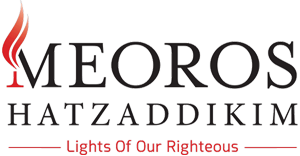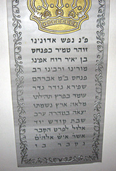Rav Pinchos Shapira of Koritz zt"l
הרב פנחס בן אברהם אבא שפירא זצ"ל
Elul 10 , 5550
Rav Pinchos Shapira of Koritz zt"l
Born: Shklov, Russia – 1728; Niftar: Shipitovka, Russia – 1790
One of the pillars of the Chassidic movement, Rav Pinchas was the son of Rav Avrohom Abba, and a descendant of Rav Nosson Shapira, the mechaber of Megale Amukos. He received a thorough Lithanian-style Torah education, becoming proficient in Tanach and Talmud, as well as in the Halachic codes and responsa. He also gained great expertise in Hebrew grammar and the writings of the great medieval philosophers. While still in his youth, he wrote Talmudic dissertations and Halachic novellae.
His father, Rav Avrohom Abba, a firm opponent of Chassidus, was forced to leave Shklov in the wake of a blood libel. He moved his family to Mirpol in Volhynia where he met the Ba’al Shem Tov and became a dedicated follower of Chassidus. His son, Rav Pinchas, also fell under the spell of the Ba’al Shem Tov, becoming one of the closest talmidim of the charismatic leader of the new movement.
The Ba’al Shem Tov is reported to have said about Rav Pinchas, “A soul such as that of Rav Pinchas comes down to this world only once in five hundred years.” At the Ba’al Shem Tov’s behest, Rav Pinchas settled in Koretz, where he studied the mysteries of the Torah and labored at perfecting his way of life, striving for uncompromising truthfulness and conquering all traces of arrogance. Recognizing the purity of his soul, many people from all walks of life, among them outstanding Rabbonim, joined the circle of his talmidim.
For unknown reasons, Rav Pinchas moved to Ostroh in Volhynia, after having stayed in Koretz for twenty years. In 1790, he decided to settle in Tzefas, Eretz Yisrael. En route, he sojourned in Shipitovka. It was there that he fell ill and passed away.
Rav Pinchas devoted many hours to the study of the Zohar, and instructed his talmidim to learn Zohar every day. He said that the study of Zohar is a good remedy for sustenance and conquering all traces of arrogance.
Rav Pinchas did not write any seforim, although his thoughts are mentioned in the writings of many other Rebbes. The comments and insights of Rav Pinchas have been anthologized by his talmidim under various titles: Pe’er LaYesharim, Nofes Tzufim and others. A comprehensive compendium was published, entitled Imrei Pinchas, from a manuscript that survived the Holocaust and was discovered in Poland.
The words of wisdom of Rav Pinchas of Koretz are written in the sefer Medrash Pinchas.
About Anger... “For many years I wrestled with my anger, until finally I conquered him and placed him in my pocket. Now I take him out only when I need him. But I am so angry with him, that I do not ever want to take him out again!”
About Prayer... “A tefilla which is not said in the name of all of K’lal Yisrael is not a tefilla. If we look at most of the formal tefillos, they are not for ourselves but for all of us. They are not written in the singular but in the plural. We daven in a congregation to remind us that we are not alone in our needs.”
The Source of Depression... “One of the roots of gloominess is pride. An arrogant person thinks that the world owes him honor and respect. He always feels slighted, believing that people disdain and snub him. As a result, he is always in a somber mood. A humble man cheerfully accepts everything that comes his way.”
(Medrash Pinchas)
Stories of Rav Pinchos Shapira of Koritz zt"l
Many tzaddikim attended the wedding of Rav Avrohom Shimshon. The Baal Shem Tov himself was the guest of honor, and Rav Pinchos Koretzer was among the many notables in attendance. As was customary, the chuppah was held outdoors in the courtyard of the shul. On the windowsill, a bird stood merrily chirping. The Baal Shem Tov turned to Rav Pinchos Koretzer and asked him, “Do you hear what that bird is saying?” He continued, “The bird is saying the pasuk, “Le’eleh techalek ha’aretz (“Among these shall the land be divided”). Hearing this, many of the guests rejoiced, as they imagined that, during this couple’s lifetime, the great Division of Eretz Yisroel would begin – a sign of the imminent redemption!
However, years later, when Rav Avrohom Shimshon decided to move to Eretz Yisroel, his wife protested and refused to go. The couple appeared before Rav Pinchos of Koretz seeking a resolution to their marital strife. “What can I do?” Rav Pinchos exclaimed. “This case has already been decided by the holy Baal Shem Tov! At your wedding, he heard a bird saying “Le’eleh techalek ha’aretz” – and now I understand that you shall be divided because of the Land of Israel that lies between you.” The halacha states that, if a husband wishes to move to Eretz Yisroel and his wife refuses to accompany him, she may accept a get (legally divorce him) so he will be free to go. And so it was that Rav Avrohom Shimshon left for Eretz Yisroel alone. (Zechuyos Yosef)
The Imrei Chaim of Vizhnitz once participated in a vacht nacht (a seudah conducted in order to provide protection a baby boy the night before the bris milah, during which, divrei Torah and keriyas Shema are recited). After all those who were present recited keriyas Shema as is customary, the rebbe told over the following:
Rav Pinchos of Koretz once approached Rav Mordechai, the chazzan of Zaslov, and asked him, “You perform at many simchas and recite Shema at many vacht nachts. Tell me, why do we recite keriyas Shema on the night before the bris?”
The chazzan said to Rav Pinchos as follows: “Chazal ask (Berachos 13a) ‘Why does the parsha of Shema precede the parsha of V’haya im shmoa?’
And they answer: ‘Because first, we accept upon ourselves the yoke of the Kingship of Heaven - and only afterwards the yoke of the mitzvos.’
Based on this, we can explain the custom just fine. Since this baby will enter into the yoke of the covenant of mitzvos tomorrow, we need to first accept upon ourselves the yoke of G-d’s Kingship; so, we accept Ol Malchus Shomayim first by reciting Shema on the night before the bris.”
A printer from Russia named Asher once came before Rav Pinchos of Koritz, holding a copy of the edition of the holy sefer Ohr HaChaim HaKadosh that he had printed in Shklov (in the year Tav-Kuf-Mem-Alef). Rav Pinchos was initially overjoyed to receive a new edition of such a holy sefer, which he so greatly esteemed. However, he was soon greatly aggrieved and disappointed upon turning to parshas Re’eh, when he noticed that at the end of the Ohr HaChaim’s teachings on the pasuk in Devarim, 15:7, where he writes, “Moshiach Hashem shemo Chaim,” this entire statement was missing from the sefer! When Rav Pinchos asked the printer about this mistake why he had omitted this line, the printer explained that he had done so on purpose. “Everyone knows that the author meant himself, since his name is Chaim. How could I print such a thing?! So I left it out.”
Rav Pinchos Koritzer was very upset. He immediately turned to parshas Naso in Bamidbar (5:22), and pointed to another printer’s error — yet this time, there was no mistake!
“Here,” said Rav Pinchos to the shocked printer, Asher, “see for yourself. Your own signature left here in your edition!” In so saying, he pointed to the words of the Ohr HaChaim describing the Gemara Sotah 18a, where it says that the Sotah is declared pure because she was not defiled, not from this man or another man. The words in the original, correct printing say, “Beyn me'ish zeh beyn me’acher.” However, the wicked printer had left his mark here, and instead, in his edition, it read, “Beyn MeAsher" — his name, Asher, pointing to his own wicked deeds and disgrace!
(Imrei Pinchos, Volume 2, p. 59, and Alef Kesav, #683)
I once heard from a Bershader chassid that Rav Pinchos Koretzer used to say that studying the sefer Ohr haChaim haKadosh is a segulah for the neshamah, similar to studying the Zohar haKadosh.
This is because Rashbi had the neshama of Moshiach of his generation, and also Rav Chaim ben Attar author of the Ohr haChaim haKadosh also had the neshama of Moshiach of his generation. He ordered his descendants, the Shapiro grandchildren of the Slovita Press to publish the Sefer Ohr haChaim HaKadosh and that that would save them from evil and harm. They fulfilled his command until there were so many published editions of the Ohr haChaim, that the seforim greatly outnumbered the demand and there were no buyers left to purchase copies. Therefore, they stopped publishing copies of the sefer, that very year that they ceased publishing the Ohr haChaim the infamous libel occurred and they were falsely accussed. (Migdal Oz pg 268 cited by Likkutei Imrei Pinchos Sha'ar haTorah 15)
The Holy tzadik Rav Pinchos Koretzer was able to achieve that when his grandson, the Shapiro brothers of Slavita were being flogged, angels stood at their backs to receive the blows. (Sippurei Maran HaRamach cited by Likkutei Imrei Pinchos Sippurim 126)
Divrei Torah of Rav Pinchos Shapira of Koritz zt"l
the broken vessels
Rav Pinchas of Koritz explained: [At the time of creation the light of Hashem flowed from the sphere of the spiritual down to the physical world through a series of vessels or emanations.] But the vessels proved unable to contain the Divine Light. They broke. This primordial catastrophe is called sheviras HaKeilim, the Breaking of the Vessels. You can better understand it with an analogy. Think of a man who is deeply troubled and depressed. Suddenly he receives an exhilarating piece of good news. His troubles are over. Instead of jumping for joy, the man will break down crying. The “bright light” of the good news was too much for him. Similarly, sheviras HaKeilim means that the vessels broke because they could not encompass the brilliant splendor of the luminescent Divine Light.
(Imrei Pinchas, Bereishis 9)
Segulos of Rav Pinchos Shapira of Koritz zt"l
A pauper once came to the home of Rav Pinchos of Koretz’s and asked to borrow a sefer to pawn and use as collateral against a loan. Rav Pinchos’ son searched for a sefer that was studied from only infrequently and found a copy of Moreh Nevuchim.
When he asked his father if he could lend the pauper the Rambam’s Moreh Nevuchim however, Rav Pinchos refused, explaining that “just having a copy of the Rambam’s seforim in the home [are a segula to] bring down yiras shomayim onto a person.” (Imrei Pinchos Shaar haTorah 124, see also Midrash Pinchos p. 43b #9)


